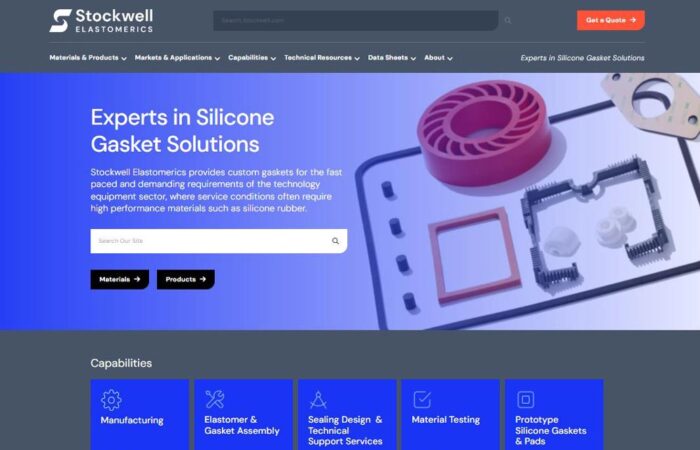Contact Stockwell Elastomerics
Request a quote or get more information.
Silicones are fully cured after the complete cure cycle, which typically occurs in 30 to 120 seconds at temperatures from 300° to 335° F. This allows the part to be stretched as needed to remove from the tooling without permanently deforming the part. The hot tear strength of LSR formulations makes it possible to de-mold even large parts without damage. This feature of LSR makes it possible to design and build injection molds without expensive draft angles and ejector pins.
Ejector pins and slides require clearance in the tool to perform. However, since LSR flows into its least restriction and is of very low viscosity, it would tend to clog any of these clearance features. Further, if the clearance between the ejector pin and bushing guide opened further due to normal wear, material flashing would be the likely result.
Generally the molds are not interchangeable. The process of molding TPR is different from molding LSR in many ways. Silicone rubber is mixed at room temperature and injected into a hot mold. The silicone is fully cured and generally capable of being stretched and bent at the end of the cure cycle without deforming the part. TPR is heated and injected into a cold mold. Many TPR materials are subject to deformation if they are mishandled during the de-molding process. Therefore the frequent need for ejector pins and similar tooling features. TPR molds often contain features to cool or heat the tooling.
TPR molds usually require a highly polished tool surface finish to aid the flow of material through the mold. With liquid silicone rubber, standard tooling surfaces are 32 to 60 micro inch finish, and for certain designs requiring a slightly roughened surface, we have provided textured finishes – such as a 150 micro inch bead blast finish.
RMA A2 Precision and RMA A3 Commercial are the main tolerance tables used. Both charts have fixed dimensions and closure dimensions. Closure dimensions can be held tighter than RMA A2 in liquid silicone rubber molding. Flash is either removed as a tear trim along the parting line with minor secondary trimming or cryogenically de-flashed – depending on configuration such as wall thickness, size of the part and production quantities.
Aluminum expands more than steel under heat. And from our experience, the performance of aluminum is less predictable and will not take the high closure pressures under temperature that machined steel will take. We can plan the layout to cut one cavity for trial fit while leaving room for runners for additional cavities. However, the additional cavities must be added within approximately 500 to 1000 heats. We commonly do this for customers; however, this requires good communication between engineering, quality and purchasing so that design approvals, first article approvals and authorization to add production cavities are communicated in a timely manner.
LSR is a closed 2 component system. The A and B components are supplied to us in closed and sealed 5 or 55 gallon drums. Care is taken to reduce exposure to air as a normal precaution; however, this is not as critical as with molding TPR. Temperature of the molding facility can be a concern. Our molding facility is air conditioned, which helps especially in maintaining consistency whether the production run is made in winter or summer.
For answers to others questions or to request further clarification, Contact Us for further assistance.
Request a quote or get more information.

